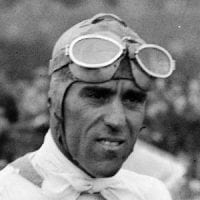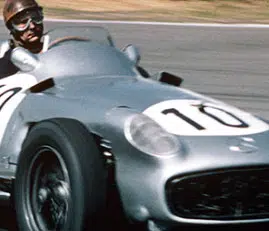
Tazio Nuvolari
Some names in motor racing history are immortal and Nuvolari is one such. It was not the number of victories for others won more often. It was his style, his achievements against the odds (he often drove for the underdog) and the image of a slight man deftly taming the awesome cars of his time.
Upbringing and early racing career
Tazio Nuvolari’s driving style was unique – animated and engaging to the public. He is credited with inventing four-wheel drift to steer the car. His yellow shirt with TN monogram and his tortoise lucky charm became Nuvolari’s trademarks. The tortoise was given to him by poet Gabriele d’Annuzio who said “to the fastest man in the world, the slowest animal”.
Nuvolari was the fourth son of Arturo – a wealthy farmer and a cyclist of some renown. He lived less than two miles from Antonio Ascari’s birthplace who was four years his senior.
Tazio Nuvolari began racing motorbikes in 1915 but he was called up and served as a driver when Italy joined World War I. The conflict delayed his competitive bike career until June 1920 at Cremona and his first taste of cars came at Garda in 1921 when fourth.
Fifth in the Penya Rhin voiturette race near Barcelona, he scored his first motorcycle victory in 1923. Nuvolari was crowned as 1924 500cc Italian Motorcycle Champion and also won his first car races at Tigullio, Savio and Polesine.
He tested an Alfa Romeo P2 at Monza on September 1 1925 as the team looked to replace Ascari who had been killed five weeks earlier. Nuvolari was quick but crashed when the gearbox broke. Ordered to rest for a month, he returned heavily bandaged 12 days later to win the Nations Grand Prix at Monza – Italy’s foremost motorbike race of the time.
He concentrated on bikes before returning to cars at the 1927 Mille Miglia after selling land to buy a Bugatti T35. He scored five wins with the car during which he continued an old motorcycle rivalry with Achille Varzi.
Grand Prix star on two and four wheels
He rode in his final bike race in 1930 and his greatest years as an international GP driver began. Legend has it that Nuvolari drove his Alfa Romeo without his headlights on at night to surprise Varzi near the finish and win that year’s Mille Miglia. The facts may not bare close scrutiny but his win and victory in Britain’s Tourist Trophy established Nuvolari’s fame outside Italy.
Nuvolari won the 1931 Targa Florio and Italian GP and was now the man to beat in GP racing. Centre stage in 1933, he starred at Monaco in a race-long duel with Varzi before his engine failed on the final lap before winning a thrilling Le Mans 24 Hours.
The Alfa Romeo 8C “Monza” he shared with Raymond Sommer was the class of the field but delays left Nuvolari chasing Luigi Chinetti’s similar car onto the last lap. He took the lead on the Mulsanne Straight only for his rival to retake the position. Nuvolari was not to be denied and he retook the lead at Arnage.
Mercedes-Benz and Auto Union entered GP racing in 1934 and the German teams began a period of near-total domination. Nuvolari was barred from joining Auto Union by its other contracted drivers and so drove out-of-date Bugattis and Maseratis (racing with a broken leg at Avus) before rejoining Enzo Ferrari’s Alfa Romeo team for 1935 after pressure from Italian Prime Minister Mussolini.
Nuvolari’s greatest victory
He managed to score notable giant-killing victories against the “Silver Arrows” and his last-lap success in the 1935 German GP was so unexpected that officials did not have (or the band did not know) the Italian national anthem. It is said that guest-of-honour Adolf Hitler refused to shake hands with the winner afterwards, so affronted was he by a foreign win. That was Nuvolari’s greatest victory.
With no logical right to beat the modern German cars, he won the Hungarian GP in Budapest’s Nepliget Park and Coppa Ciano on Livorno’s Montenero circuit during 1936. In the latter he took over Pintacuda’s car having retired his own and hauled in the Auto Unions – passing them one-by-one. In trying to withstand his challenge, Auto Union’s drivers responded by over-cooking their brakes and that allowed two more Alfa Romeos through for a rare 1-2-3 for the marque. His fame spread across the ocean when he soundly defeated the local drivers in the George Vanderbilt Cup on Long Island.
However, Alfa Romeo was increasingly uncompetitive and Nuvolari endured an unsuccessful 1937. He was then burnt at the start of 1938 when his car burst into flames at Pau. Nuvolari steered the car to a stop but vowed never to drive for the team again.
Auto Union delivers his final Grand Prix wins
He finally accepted an offer to drive for Auto Union later that year when replacing the mourned Bernd Rosemeyer. Nuvolari was one of the few to master the difficult rear-engine machines and he won both the Italian and Donington GPs that season. It was entirely appropriate that Nuvolari should win the last race before World War II – the Yugoslav GP held on the very day war was declared.
Nuvolari raced after the conflict had ended but he was by now suffering lung haemorrhages apparently caused by years of inhaling petrol fumes. He won at Albi in 1946 but collapsed after the finish and was seen driving with blood soaked cloth to his mouth on occasion.
Second in the following season’s Mille Miglia with a 1100cc Cisitalia, he retired while leading the 1948 race. He competed for a final time at the Monte Pelligrino hillclimb on April 10 1950 and died in his bed three years later. He was buried wearing the clothes and helmet in which he had raced with such distinction.
Personal tragedy (his two sons had died before reaching 20 years old), indomitable spirit (he raced with many a broken bone) and undoubted skill made “Il Mantovano Volante” the people’s champion. Dr Ferdinand Porsche described Nuvolari as “the greatest driver of the past, the present or the future”.





